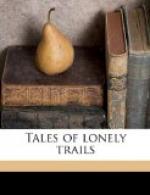Later, R.C. and I rode up a mile or so above camp, and hitched our horses near Teague’s old corral. Our intention was to hunt up along the side of the slope. Teague came along presently. We waited, hoping the big black clouds would break. But they did not. They rolled down with gray, swirling edges, like smoke, and a storm enveloped us. We sought shelter in a thick spruce. It rained and hailed. By and bye the air grew bitterly cold, and Teague suggested we give up, and ride back. So we did. The mountains were dim and obscure through the gray gloom, and the black spear-tipped spruces looked ghostly against the background. The lightning was vivid, and the thunder rolled and crashed in magnificent bombardment across the heavens.
Next morning at six-thirty the sun was shining clear, and only a few clouds sailed in the blue. Wind was in the west and the weather promised fair. But clouds began to creep up behind the mountains, first hazy, then white, then dark. Nevertheless we decided to ride out, and cross the Flattop rim, and go around what they call the Chinese Wall. It rained as we climbed through the spruces above Little Trappers Lake. And as we got near the top it began to hail. Again the air grew cold. Once out on top I found a wide expanse, green and white, level in places, but with huge upheavals of ridge. There were flowers here at eleven thousand feet. The view to the rear was impressive—a wide up-and-down plain studded with out-cropping of rocks, and patches of snow. We were then on top of the Chinese Wall, and the view to the west was grand. At the moment hail was falling thick and white, and to stand above the streaked curtain, as it fell into the abyss was a strange new experience. Below, two thousand feet, lay the spruce forest, and it sloped and dropped into the White River Valley, which in turn rose, a long ragged dark-green slope, up to a bare jagged peak. Beyond this stretched range on range, dark under the lowering pall of clouds. On top we found fresh Rocky Mountain sheep tracks. A little later, going into a draw, we crossed a snow-bank, solid as ice. We worked down into this draw into the timber. It hailed, and rained some more, then cleared. The warm sun felt good. Once down in the parks we began to ride through a flower-garden. Every slope was beautiful in gold, and red, and blue and white. These parks were luxuriant with grass, and everywhere we found elk beds, where the great stags had been lying, to flee at our approach. But we did not see one. The bigness of this slope impressed me. We rode miles and miles, and every park was surrounded by heavy timber. At length we got into a burned district where the tall dead spruces stood sear and ghastly, and the ground was so thickly strewn with fallen trees that we had difficulty in threading a way through them. Patches of aspen grew on the hillside, still fresh and green despite this frosty morning. Here we found a sego lily, one of the most beautiful of flowers. Here also I saw pink Indian paint brush. At the foot of this long burned slope we came to the White River trail, and followed it up and around to camp.




